Systems can be sited near major urban markets
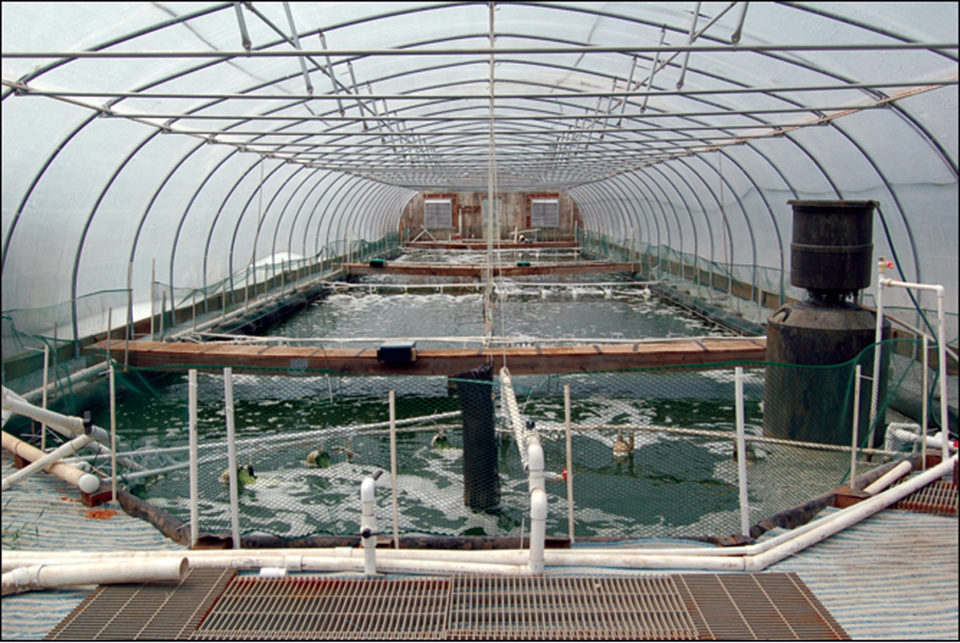
In recent years, research to support the commercialization of indoor, super-intensive biofloc cultivation of Pacific white shrimp (Litopenaeus vannamei) in the United States has continued under the auspices of the U.S. Department of Agriculture’s U.S. Marine Shrimp Farming Program.
The shrimp research group at the South Carolina Department of Natural Resources Waddell Mariculture Center (WMC) in Bluffton, South Carolina, USA, has been productively working to develop protocols for the indoor commercial grow-out of L. vannamei for the program. Since WMC opened its doors in 1986, it has been a leader in the development of minimal-exchange, biofloc culture systems.
WMC raceway
Waddell Mariculture Center operates a prototype commercial-scale raceway and several smaller raceways and tanks for replicate studies. The large greenhouse-enclosed, in-ground raceway is approximately 33.5 meters x 7.6 meters (235 cubic meters). Two settling tanks, each with an operating volume of about 6 cubic meters, are used to manage the concentration of solids. Oxygen is supplied via a 10-kW oxygen generator with two 1-hp pumps. The raceway is heated by a propane boiler using a 1-hp pump.
Aeration and circulation are achieved via 56 airlifts powered by a 5-hp blower. Research trials have stocked this raceway at densities ranging 300 to 1,000 shrimp per cubic meter, depending on the specific research question. Densities near 500 per cubic meter yield good survival, growth and feed conversion in the system.
Minimal exchange
An advantage of zero- or minimal-exchange recirculating systems is that the naturally occurring biofloc in the water column processes nitrogenous wastes within the system and provides supplemental feed to the shrimp. Biofloc is the aggregation of bacteria, algae, micro-invertebrates, uneaten feed, shrimp feces and molts suspended in the water column.
While this rich microbial community provides important benefits, there are also costs. During a raceway trial in 2009-2010 with a shrimp density of 414 per cubic meeter, the authors carefully measured the total oxygen demand of the raceway, shrimp and microbes, both suspended in the water column and attached to the sides of the tank.
As the trial neared harvest, the entire system consumed approximately 4.9 mg oxygen/L/hour. At these levels, any disruption of supplemental oxygen to the system has severe consequences in as little as 30 minutes. While the shrimp oxygen demand increased with rising biomass, the microbial oxygen demand remained high at about 2.0 mg/L/hour and relatively constant throughout the grow-out trial.
Since there is no water exchange, these systems can be sited inland, where land is less expensive and in the vicinity of major urban markets. Synthetic, medium-salinity seawater can be made on site and recycled over the course of several grow-out runs, significantly reducing costs and discharges. Freshwater is added only to replace evaporative loss.
Water recycling
Water recycling enhances biosecurity. Since the iso-osmotic concentration for L. vannamei is in the 20- to 25- ppt range, medium-salinity seawater is physiologically advantageous for shrimp growth, while still providing adequate levels to offset possible nitrite toxicities.
Water recycling from run to run also facilitates faster turnaround between harvest and restocking, eliminating the need to condition new water before each restocking. Waddell Mariculture Center also acclimates juvenile shrimp to the grow-out raceway water by slowly running existing raceway water through the adjacent nursery tank starting about two weeks prior to stocking.
Conditioned, recycled water is also inherently more stable in that the total ammonia nitrogen and nitrite spikes experienced in the early part of grow-out have already occurred. Because the biofloc particles containing established populations of nitrogen-oxidizing bacteria are already present, only brief, very low spikes of ammonia and nitrite following stocking are seen (Fig. 1).
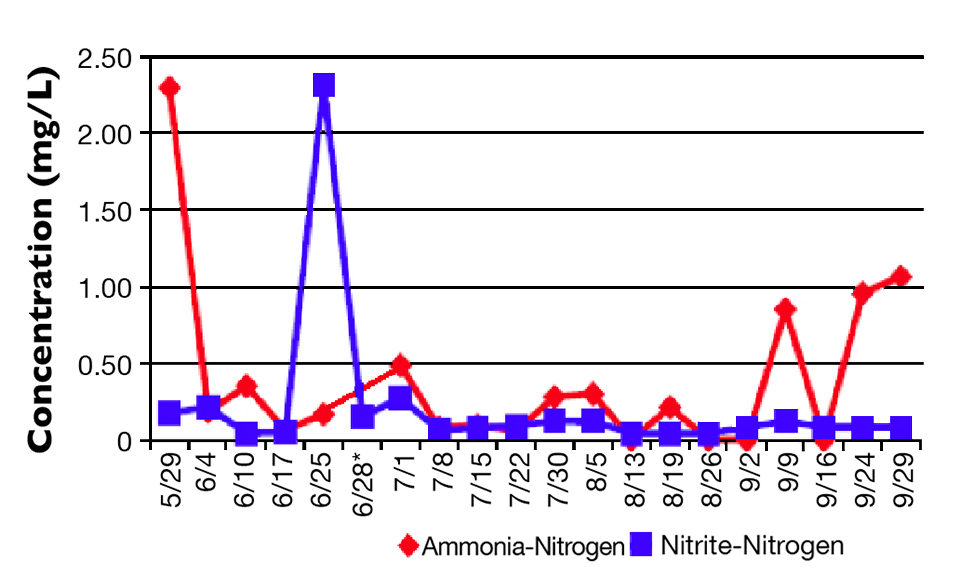
Biofloc-based grow-out with recycled water is not perfect, however. During a four-month trial using 27 percent recycled water in early 2010, several inorganic ions accumulated within the water and biofloc, and small amounts of arsenic, cadmium, lead and selenium accumulated within the shrimp, although none were close to reaching U.S. Environmental Protection Agency screening values.
Another concern with water recycling is the possibility that the build-up of substances in the water may reduce shrimp growth. A WMC study in which heavily used raceway water was diluted serially with fresh seawater found that weekly shrimp growth decreased with increasing concentrations of “old” raceway water. Shrimp grown in 100 percent new water exhibited growth of 1.0 grams per week, while shrimp grown in 100 percent “old” raceway water grew about 0.6 grams per week (Fig. 2).
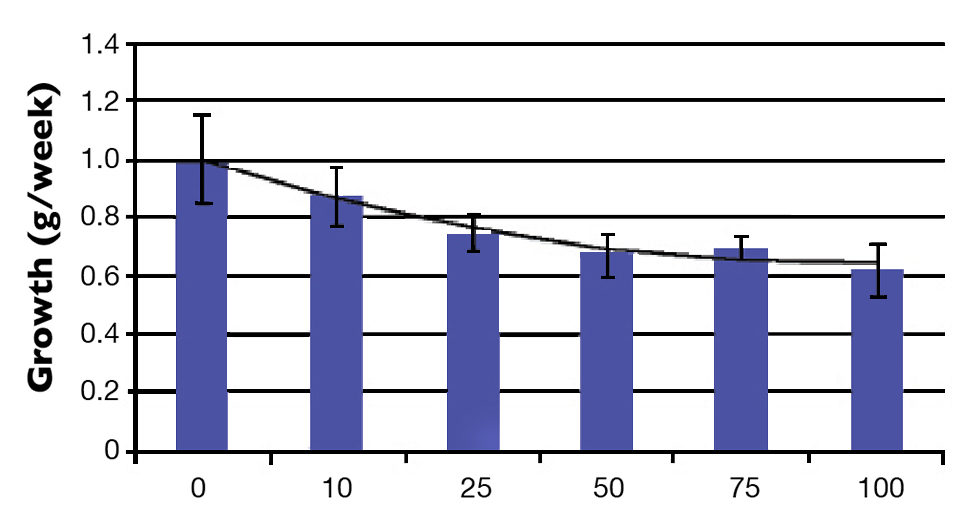
Although minimal exchange and water recycling eliminate regular discharges of wastewater, as chemicals accumulate, the eventual disposal of water with elevated chemical levels could create a problem with obtaining discharge permits from regulatory agencies. One approach might be to use “old” water to grow alternative plant crops on site.
Economic analysis
Researchers at WMC tracked actual operating costs during a 128-day grow-out trial between October 2009 and February 2010. Winter heating costs accounted for 29 percent of expenditures, with propane costing nearly $5,900. Feed costs were approximately $5,400, and electricity for the pumps and blower accounted for about $4,000. Labor time, valued at $10/hour, was recorded as actual non-research activities involving routine feeding, monitoring, maintenance, stocking and harvesting.
The total operating costs for the winter grow-out exceeded U.S. $20,000, equating to about $14.60/kg of shrimp harvested (Table 1). Even if the system had been operated during warm months and required no heating, the costs would have been $10.43/kg. Given today’s market prices, this would not be a sustainable venture.
DuRant, Costs for a prototype, commercial-scale shrimp, Table 1
| Input | Amount Used | Cost/Unit (U.S. $) | Total Cost (U.S. $) | Cost/kg (U.S. $) |
|---|---|---|---|---|
| Feed | 3,492.5 kg | 1.56 | 5,448.30 | 3.86 |
| Electricity | 50,350.6 kWh | 0.08 | 4,028.04 | 2.87 |
| Labor | 128.2 hours | 10.00 | 1,282.00 | 0.90 |
| Sodium bicarbonate | 362.8 kg | 1.18 | 428.12 | 0.31 |
| Propane | 11,894.7 L | 1.28-2.35 | 5,865.85 | 4.17 |
| Juvenile shrimp | 116,424 | 0.03 | 3,492.72 | 2.49 |
| Freshwater from well | 69,010 L | 0 | 0 | 0 |
| Total | 20,545.03 | 14.60 |
Other researchers have achieved production costs nearly half of those reported here. The WMC greenhouse-based research system has a large propane boiler and electrically operated oxygen generator that are not particularly efficient to operate. One would expect a commercial enterprise to be better designed. In addition, the 2009-2010 winter was particularly cold, which drove up both heating demand and the cost of propane. This was also not one of the more productive trials. Although survival was 79 percent, growth rate was only 0.77 grams per week with a feed-conversion ratio of 2.2.
Authors
-
Edward DuRant
South Carolina Department of Natural Resources
Waddell Mariculture Center
Bluffton, South Carolina 29910 USA[118,111,103,46,99,115,46,114,110,100,64,101,116,110,97,114,117,100]
-
Jason Haveman
South Carolina Department of Natural Resources
Waddell Mariculture Center
Bluffton, South Carolina 29910 USA -
Jeffrey Brunson
South Carolina Department of Natural Resources
Waddell Mariculture Center
Bluffton, South Carolina 29910 USA -
Dr. John Leffler
South Carolina Department of Natural Resources
Marine Resources Research Institute
Charleston, South Carolina, USA
Tagged With
Related Posts
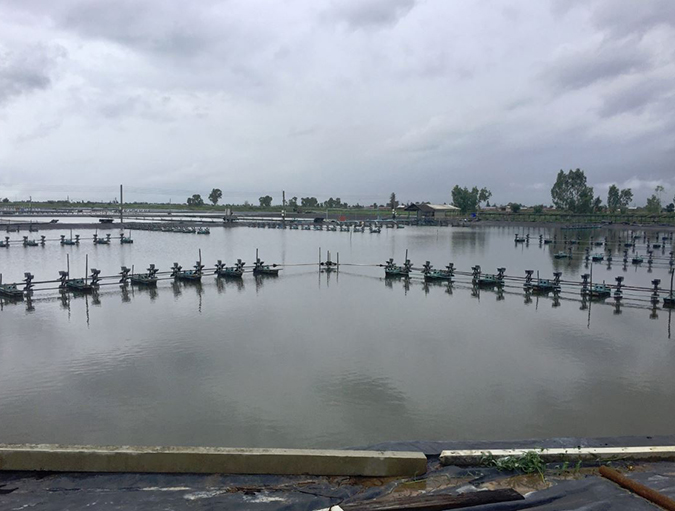
Health & Welfare
Aquamimicry: A revolutionary concept for shrimp farming
Aquamimicry simulates natural, estuarine production conditions by creating zooplankton blooms as supplemental nutrition to the cultured shrimp, and beneficial bacteria to maintain water quality. Better-quality shrimp can be produced at lower cost and in a more sustainable manner.
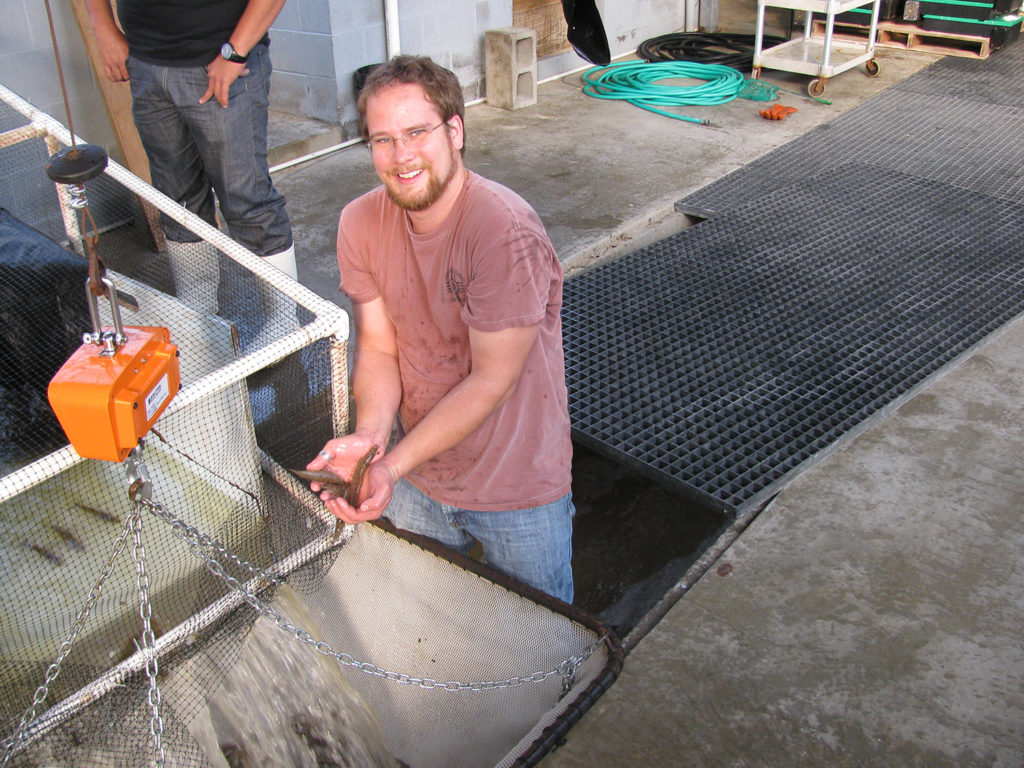
Health & Welfare
Comparing salinities in intensive, commercial-scale biofloc for Pacific white shrimp
Study illustrates the range of salinity options for shrimp production in commercial-scale biofloc systems and found no significant differences in any shrimp production metric.
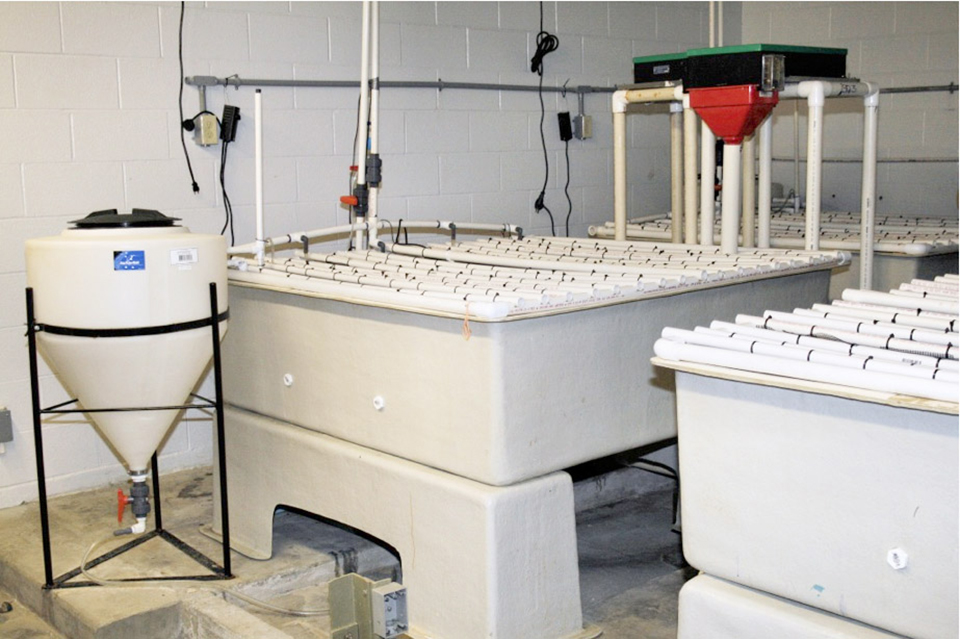
Health & Welfare
Shallow nursery system uses bioreactor concept for juvenile shrimp production
The authors tested the effects of sequencing autotrophic and heterotrophic dominance on water quality levels in a recirculating system raising shrimp. Culture tanks were inoculated with nitrifying bacteria, and chemoautotrophic dominance was maintained.
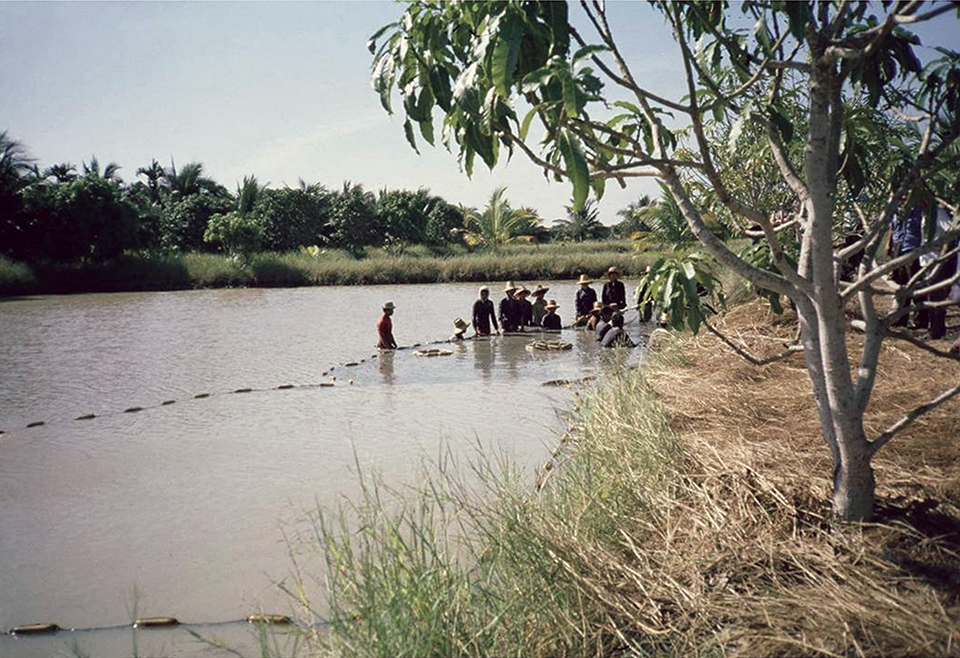
Health & Welfare
‘Big picture’ connects shrimp disease, inbreeding
Disease problems on shrimp farms may be partly driven by an interaction between management practices that cause inbreeding in small hatcheries and the amplification by inbreeding of susceptibility to disease and environmental stresses.


